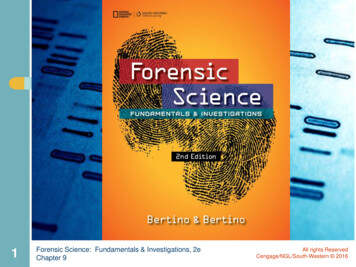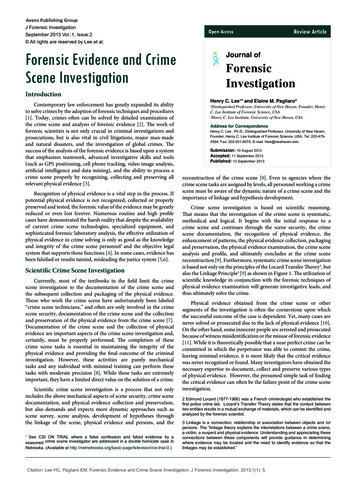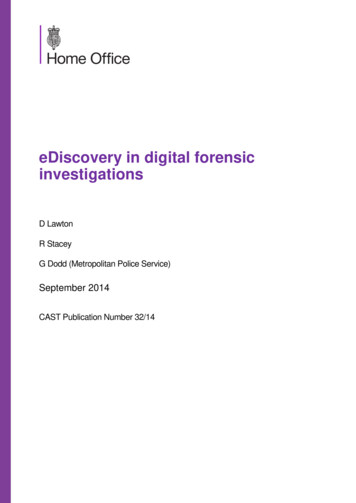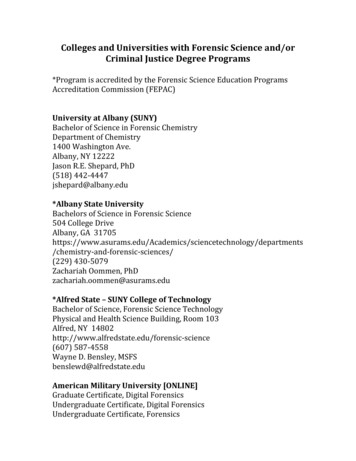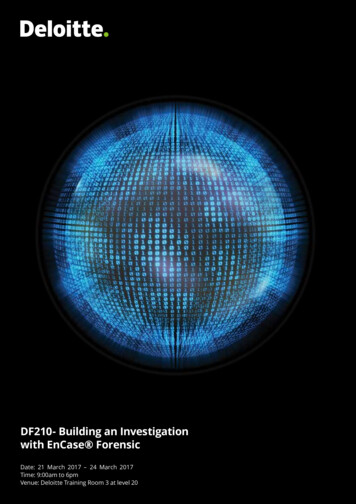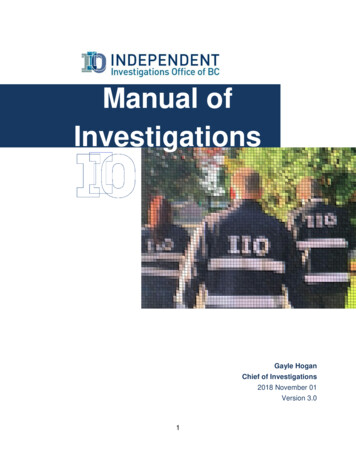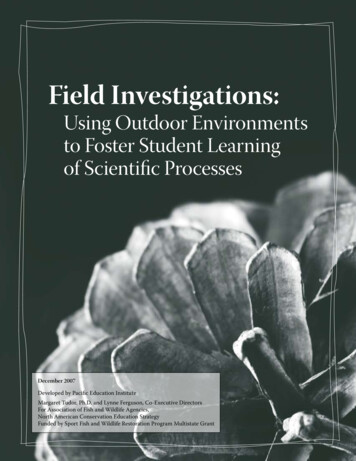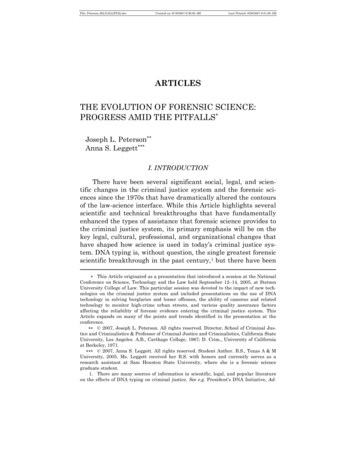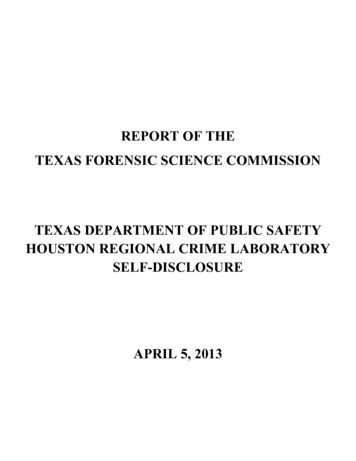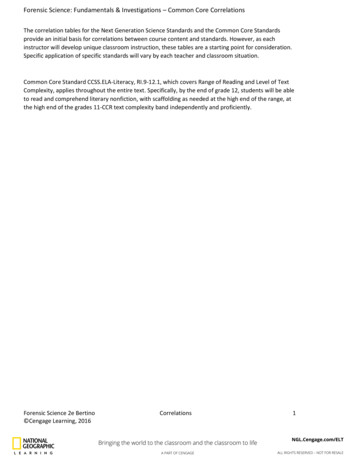
Transcription
Forensic Science: Fundamentals & Investigations – Common Core CorrelationsThe correlation tables for the Next Generation Science Standards and the Common Core Standardsprovide an initial basis for correlations between course content and standards. However, as eachinstructor will develop unique classroom instruction, these tables are a starting point for consideration.Specific application of specific standards will vary by each teacher and classroom situation.Common Core Standard CCSS.ELA-Literacy, RI.9-12.1, which covers Range of Reading and Level of TextComplexity, applies throughout the entire text. Specifically, by the end of grade 12, students will be ableto read and comprehend literary nonfiction, with scaffolding as needed at the high end of the range, atthe high end of the grades 11-CCR text complexity band independently and proficiently.Forensic Science 2e Bertino Cengage Learning, 2016Correlations1
Forensic Science: Fundamentals & Investigations – Common Core CorrelationsChapter 1 Observation SkillsIntroductionWhat is Observation?Digging Deeper with Forensic Science e-CollectionObservations by WitnessesEyewitness AccountsThe Innocence ProjectsHow to be a Good ObserverDigging Deeper with Forensic Science e-CollectionObservations in ForensicsWhat Forensic Scientists DoChapter SummaryCase StudiesCareers in Forensics Paul EkmanChapter 1 ReviewActivity 1-1 Learning to SeeActivity 1-2 You’re an Eyewitness!Activity 1-3 What Influences Our Observations?Next Generation Science Standards (NGSS)HS-LS3-1 Ask questions to clarify relationships aboutthe role of DNA and chromosomes in coding theinstructions for characteristic traits passed fromparents to offspring.HS-LS3-3 Apply concepts of statistics and probabilityto explain variation and distribution of expressedtraits in a population.HS-ETS1-2 Design a solution to a complex real-worldproblem by breaking it down into smaller, moremanageable problems that can be solved throughengineering.Common Core (CCSS Literacy)RST.9-10.1 Cite specific textual evidence tosupport analysis of science.RST.9-10.3 Follow precisely a multistepprocedure when carrying out experimentsRST.9-10.4 Determine the meaning ofsymbols, key terms and phrases.RST.11-12.1 Cite specific textual evidence tosupport analysis of science.RST.11-12.3 Follow precisely a multistepprocedure when carrying out experiments.RST.11-12.4 Determine the meaning ofsymbols, key terms and phrases.WHST.9-10.1 Write arguments focused onscience content.WHST.9-10.2 Write informative/explanatorytexts, including the narration of historicalevents, scientific procedures/experiments ortechnical processes.WHST.9-10.7 Conduct short as well as moresustained research projects to answer aquestion or solve a problem.WHST.11-12.1 Write arguments focused onscience content.WHST.11-12.2 Write informative/explanatorytexts, including the narration of historicalevents, scientific procedures/experiments ortechnical processes.WHST.11-12.7 Conduct short as well as moresustained research projects to answer aquestion or solve a problem.Common Core (CCSS Mathematics)HSN.Q.A.1 Use units as a way to understandproblems and to guide the solution of multistep problems; choose and interpret unitsconsistently in formulas; choose andinterpret the scale and the origin in graphsand data displays.Forensic Science 2e Bertino Cengage Learning, 2016Correlations2
Forensic Science: Fundamentals & Investigations – Common Core CorrelationsChapter 2 Crime-Scene Investigation and Evidence CollectionIntroductionCommon Core (CCSS Literacy)Principles of ExchangeRST.9-10.3 Follow precisely a multistepTypes of Evidenceprocedure when carrying out experiments.The Crime-Scene Investigation TeamRST.9-10.4 Determine the meaning ofThe Seven S’s of Crime-Scene Investigationsymbols, key terms and phrases.Securing the SceneRST.11-12.1 Cite specific textual evidence toSeparating the Witnessessupport analysis of science.Scanning the SceneRST.11-12.3 Follow precisely a multistepSeeing the Sceneprocedure when carrying out experimentsSketching the SceneRST.11-12.4 Determine the meaning ofSearching for Evidencesymbols, key terms and phrases.Securing and Collecting EvidenceWHST.9-10.1 Write arguments focused onDigging Deeper with Forensic Science e-Collectionscience content.Mapping the Outdoor Crime SceneWHST.9-10.2 Write informative/explanatoryAnalyzing The Evidencetexts, including the narration of historicalCrime-Scene Reconstructionevents, scientific procedures/experiments orStaged Crime Scenestechnical processes.Chapter SummaryWHST.11-12.2 Write informative/explanatoryCase Studiestexts, including the narration of historicalCareers in Forensics Crime Scene Investigatorevents, scientific procedures/experiments orChapter 2 Reviewtechnical processes.Activity 2-1 Locard’s Exchange PrincipleActivity 2-2 Crime-Scene InvestigationNext GenerationScience Standards (NGSS)STEMTopicsHS-ETS1-2 Design a solution to a complex real-worldproblem by breaking it down into smaller, moremanageable problems that can be solved throughengineering.Common Core (CCSS Mathematics)HSN.Q.A.1 Use units as a way to understandproblems and to guide the solution of multistep problems; choose and interpret unitsconsistently in formulas; choose andinterpret the scale and the origin in graphsand data displays.HSG.SRT.C.6 Understand that by similarity,side ratios in right triangles are properties ofthe angles in the triangle, leading todefinitions of trigonometric ratios for acuteangles.Forensic Science 2e Bertino Cengage Learning, 2016Correlations3
Forensic Science: Fundamentals & Investigations – Common Core CorrelationsChapter 3 Hair AnalysisIntroductionHistory of Hair AnalysisThe Functions of HairThe Structure of Human HairCortex VariationTypes of MedullaTypes of HairHair From Different Parts of the BodyLife Cycle of HairTreated HairEthnic or Ancestral DifferencesAnimal Hair and Human HairCollecting Hair in an InvestigationMicroscopyDigging Deeper with Forensic Science e-CollectionHair Examination and TestingChapter SummaryCase StudiesCareers in Forensics Chemical ResearcherChapter 3 ReviewActivity 3-1 Trace Evidence: HairActivity 3-2 Hair Measurement and MatchActivity 3-3 Hair Testimony EssayCommon Core (CCSS Literacy)RST.9-10.1 Cite specific textual evidence tosupport analysis of science.RST.9-10.3 Follow precisely a multistepprocedure when carrying out experimentsRST.9-10.4 Determine the meaning ofsymbols, key terms and phrases.RST.11-12.1 Cite specific textual evidence tosupport analysis of science.RST.11-12.3 Follow precisely a multistepprocedure when carrying out experiments.RST.11-12.4 Determine the meaning ofsymbols, key terms and phrases.WHST.9-10.1 Write arguments focused onscience content.WHST.9-10.7 Conduct short as well as moresustained research projects to answer aquestion or solve a problem.WHST.11-12.1 Write arguments focused onscience content.WHST.11-12.7 Conduct short as well as moresustained research projects to answer aquestion or solve a problem.Next GenerationScience Standards (NGSS)STEMTopicsHS-ETS1-2 Design a solution to a complex real-worldproblem by breaking it down into smaller, moremanageable problems that can be solved throughengineering.HS-LS1-1 Construct an explanation based onevidence for how the structure of DNA determinesthe structure of proteins which carry out essentialfunctions of life through systems of specialized cells.Common Core (CCSS Mathematics)HSN.Q.A.1 Use units as a way to understandproblems and to guide the solution of multistep problems; choose and interpret unitsconsistently in formulas; choose andinterpret the scale and the origin in graphsand data displays.HS-LS3-3 Apply concepts of statistics and probabilityto explain variation and distribution of expressedtraits in a population.HS-PS1-1 Use the periodic table as a model topredict the relative properties of elements based onthe patterns of electrons in the outermost energylevel of atoms.Forensic Science 2e Bertino Cengage Learning, 2016Correlations4
Forensic Science: Fundamentals & Investigations – Common Core CorrelationsChapter 4 The Study of Fibers and TextilesIntroductionCollecting, Sampling and Testing Fiber EvidenceEvaluating Fiber EvidenceDigging Deeper with Forensic Science e-CollectionFiber and Textile EvidenceFiber ClassificationDigging Deeper with Forensic Science e-CollectionDigging Deeper with Forensic Science e-CollectionYarnsTextilesChapter SummaryCase StudiesCareers in Forensics Irene GoodChapter 4 ReviewActivity 4-1 Microscopic Fiber AnalysisActivity 4-2 Bedsheet Thread CountActivity 4-3 Weave Pattern AnalysisNext GenerationScience Standards (NGSS)STEMTopicsHS-ETS1-2 Design a solution to a complex real-worldproblem by breaking it down into smaller, moremanageable problems that can be solved throughengineering.HS-PS1-1 Use the periodic table as a model topredict the relative properties of elements based onthe patterns of electrons in the outermost energylevel of atoms.Common Core (CCSS Literacy)RST.9-10.1 Cite specific textual evidence tosupport analysis of science.RST.9-10.3 Follow precisely a multistepprocedure when carrying out experimentsRST.9-10.4 Determine the meaning ofsymbols, key terms and phrases.RST.11-12.1 Cite specific textual evidence tosupport analysis of science.RST.11-12.3 Follow precisely a multistepprocedure when carrying out experiments.RST.11-12.4 Determine the meaning ofsymbols, key terms and phrases.WHST.9-10.2 Write informative/explanatorytexts, including the narration of historicalevents, scientific procedures/experiments ortechnical processes.WHST.9-10.7 Conduct short as well as moresustained research projects to answer aquestion or solve a problem.WHST.11-12.2 Write informative/explanatorytexts, including the narration of historicalevents, scientific procedures/experiments ortechnical processes.WHST.11-12.7 Conduct short as well as moresustained research projects to answer aquestion or solve a problem.Common Core (CCSS Mathematics)HSN.Q.A.1 Use units as a way to understandproblems and to guide the solution of multistep problems; choose and interpret unitsconsistently in formulas; choose andinterpret the scale and the origin in graphsand data displays.Forensic Science 2e Bertino Cengage Learning, 2016Correlations5
Forensic Science: Fundamentals & Investigations – Common Core CorrelationsChapter 5 Forensic BotanyIntroductionHistory of Forensic BotanyHow Forensic Botany is Used to Solve CasesDrowning VictimsInformation from Gastric ContentsThe Body Covered by Wilted SunflowersSecrets from a GraveBotanical Crime-Scene AnalysisSearching for and Mapping Botanical EvidenceBotanical Evidence CollectionPollen and Spores in ForensicsPollen ProducersGymnospermsAngiospermsTypes of PollinationMethods of PollinationSeed DispersalSpore ProducersSpore DispersalBacterial Spores: An ExceptionPollen and Spore Identification in Solving CrimesDigging Deeper with Forensic Science e-CollectionPollen and Spore Evidence at Crime ScenesChapter SummaryDigging Deeper with Forensic Science e-CollectionCase StudiesCareers in Forensics Dr. Lynne Milne, ForensicPalynologistChapter 5 ReviewActivity 5-1 Pollen Examination: Matching a Suspectto a Crime SceneActivity 5-2 Pollen Expert Witness PresentationActivity 5-3 Botanical Evidence Case StudiesPresentationActivity 5-4 Processing a Crime Scene for BotanicalEvidenceActivity 5-5 Pollen IndexActivity 5-6 Isolating Pollen from HoneyForensic Science 2e Bertino Cengage Learning, 2016Common Core (CCSS Literacy)RST.9-10.1 Cite specific textual evidence tosupport analysis of science.RST.9-10.3 Follow precisely a multistepprocedure when carrying out experimentsRST.9-10.4 Determine the meaning ofsymbols, key terms and phrases.RST.11-12.1 Cite specific textual evidence tosupport analysis of science.RST.11-12.3 Follow precisely a multistepprocedure when carrying out experiments.RST.11-12.4 Determine the meaning ofsymbols, key terms and phrases.WHST.9-10.1 Write arguments focused onscience content.WHST.9-10.2 Write informative/explanatorytexts, including the narration of historicalevents, scientific procedures/experiments ortechnical processes.WHST.9-10.7 Conduct short as well as moresustained research projects to answer aquestion or solve a problem.WHST.11-12.1 Write arguments focused onscience content.WHST.11-12.2 Write informative/explanatorytexts, including the narration of historicalevents, scientific procedures/experiments ortechnical processes.WHST.11-12.7 Conduct short as well as moresustained research projects to answer aquestion or solve a problem.Common Core (CCSS Mathematics)HSN.Q.A.1 Use units as a way to understandproblems and to guide the solution of multistep problems; choose and interpret unitsconsistently in formulas; choose andinterpret the scale and the origin in graphsand data displays.Correlations6
Forensic Science: Fundamentals & Investigations – Common Core CorrelationsNext Generation Science Standards (NGSS)HS-ETS1-2 Design a solution to a complex real-worldproblem by breaking it down into smaller, moremanageable problems that can be solved throughengineering.HS-LS1-1 Construct an explanation based onevidence for how the structure of DNA determinesthe structure of proteins which carry out essentialfunctions of life through systems of specialized cells.HS-LS3-3 Apply concepts of statistics and probabilityto explain variation and distribution of expressedtraits in a population.Forensic Science 2e Bertino Cengage Learning, 2016Correlations7
Forensic Science: Fundamentals & Investigations – Common Core CorrelationsChapter 6 FingerprintsIntroductionHistorical DevelopmentWhat are Fingerprints?Formation of FingerprintsClassification of FingerprintsTypes of FingerprintsFingerprint Forensics FAQsThe Future of FingerprintingDigging Deeper with Forensic Science e-CollectionChapter SummaryCase StudiesCareers in Forensics Peter Paul BiroChapter 6 ReviewActivity 6-1 Study Your FingerprintsActivity 6-2 Giant Balloon FingerprintActivity 6-3 Studying Latent and Plastic FingerprintsActivity 6-4 How to Print a Ten CardActivity 6-5 Is It a Match?Activity 6-6 Fingerprint MatchingActivity 6-7 Using Cyanoacrylate to Recover LatentFingerprintsNext GenerationScience Standards (NGSS)STEMTopicsHS-ETS1-2 Design a solution to a complex real-worldproblem by breaking it down into smaller, moremanageable problems that can be solved throughengineering.HS-LS1-2 Develop and use a model to illustrate thehierarchical organization of interacting systems thatprovide specific functions within multicellularorganisms.Forensic Science 2e Bertino Cengage Learning, 2016Common Core (CCSS Literacy)RST.9-10.1 Cite specific textual evidence tosupport analysis of science.RST.9-10.3 Follow precisely a multistepprocedure when carrying out experimentsRST.9-10.4 Determine the meaning ofsymbols, key terms and phrases.RST.11-12.1 Cite specific textual evidence tosupport analysis of science.RST.11-12.3 Follow precisely a multistepprocedure when carrying out experiments.RST.11-12.4 Determine the meaning ofsymbols, key terms and phrases.WHST.9-10.2 Write informative/explanatorytexts, including the narration of historicalevents, scientific procedures/experiments ortechnical processes.WHST.9-10.7 Conduct short as well as moresustained research projects to answer aquestion or solve a problem.WHST.11-12.2 Write informative/explanatorytexts, including the narration of historicalevents, scientific procedures/experiments ortechnical processes.WHST.11-12.7 Conduct short as well as moresustained research projects to answer aquestion or solve a problem.Common Core (CCSS Mathematics)HSN.Q.A.1 Use units as a way to understandproblems and to guide the solution of multistep problems; choose and interpret unitsconsistently in formulas; choose andinterpret the scale and the origin in graphsand data displays.Correlations8
Forensic Science: Fundamentals & Investigations – Common Core CorrelationsChapter 7 DNA ProfilingIntroductionWhat is DNA?ChromosomesGenesDigging Deeper with Forensic Science e-CollectionCollection and Preservation of DNA EvidenceForensic DNA and Personal IdentificationEarly DNA Fingerprinting Using Gel ElectrophoresisShort Tandem Repeats (STRs)The FBI and the 13 Core STRsInheritance of STRsDNA STR ProfilesSTR AnalysisSTR Allele FrequenciesDigging Deeper with Forensic Science e-CollectionY STR and mtDNA AnalysisKinship and Familial StudiesCivil Liberties ConcernsRomanov Family Case Study Linking History andForensicsDigging Deeper with Forensic Science e-CollectionDNA and Forensic ScienceChapter SummaryCase StudiesDigging Deeper with Forensic Science e-CollectionCareers in Forensics Kary Banks Mullis, Nobel PrizeWinning BiochemistChapter 7 ReviewActivity 7-1 Simple DNA ExtractionActivity 7-2 The Break-InActivity 7-3 Anna Anderson or Anastasia? STRAnalysisActivity 7-4 STR Identification of September 11 VictimActivity 7-5 Identification of the Romanovs Using STRProfilingNext GenerationScience Standards (NGSS)STEMTopicsHS-ETS1-2 Design a solution to a complex real-worldproblem by breaking it down into smaller, moremanageable problems that can be solved throughengineering.Common Core (CCSS Literacy)RST.9-10.1 Cite specific textual evidence tosupport analysis of science.RST.9-10.3 Follow precisely a multistepprocedure when carrying out experimentsRST.9-10.4 Determine the meaning ofsymbols, key terms and phrases.RST.11-12.1 Cite specific textual evidence tosupport analysis of science.RST.11-12.3 Follow precisely a multistepprocedure when carrying out experiments.RST.11-12.4 Determine the meaning ofsymbols, key terms and phrases.WHST.9-10.1 Write arguments focused onscience content.WHST.9-10.2 Write informative/explanatorytexts, including the narration of historicalevents, scientific procedures/experiments ortechnical processes.WHST.9-10.7 Conduct short as well as moresustained research projects to answer aquestion or solve a problem.WHST.11-12.1 Write arguments focused onscience content.WHST.11-12.2 Write informative/explanatorytexts, including the narration of historicalevents, scientific procedures/experiments ortechnical processes.WHST.11-12.7 Conduct short as well as moresustained research projects to answer aquestion or solve a problem.Common Core (CCSS Mathematics)HSN.Q.A.1 Use units as a way to understandproblems and to guide the solution of multistep problems; choose and interpret unitsconsistently in formulas; choose andinterpret the scale and the origin in graphsand data displays.HS-LS1-1 Construct an explanation based onevidence for how the structure of DNA determinesstructure of proteins which carry out the essentialfunctions of life through systems of specialized cells.Forensic Science 2e Bertino Cengage Learning, 2016Correlations9
Forensic Science: Fundamentals & Investigations – Common Core CorrelationsChapter 8 Blood and Blood SpatterIntroductionHistory of the Study of BloodComposition of BloodBlood CellsBlood Types and ForensicsAntigen-Antibody ResponseProbability and Blood TypesBlood-Spatter PatternsHistory of Blood-Spatter AnalysisBlood-Spatter Pattern AnalysisDirectionality of BloodBloodstain PatternsArea of ConvergenceAngle of Impact CalculationsCrime-Scene Investigation of BloodConfirmation of BloodCollection of Blood EvidenceChapter SummaryCase StudiesCareers in Forensics Bloodstain Pattern AnalystChapter 8 ReviewActivity 8-1 A Presumptive Test for BloodActivity 8-2 Creating and Modeling Blood-SpatterPatternsActivity 8-3 Blood-Spatter Analysis: Effect of Heighton Blood DropsActivity 8-4 Area of ConvergenceActivity 8-5 Blood-Drop Angle ImpactActivity 8-6 Area of OriginActivity 8-7 Crime-Scene InvestigationCommon Core (CCSS Literacy)RST.9-10.3 Follow precisely a multistepprocedure when carrying out experiments.RST.9-10.4 Determine the meaning ofsymbols, key terms and phrases.RST.11-12.1 Cite specific textual evidence tosupport analysis of science.RST.11-12.3 Follow precisely a multistepprocedure when carrying out experiments.RST.11-12.4 Determine the meaning ofsymbols, key terms and phrases.WHST.9-10.1 Write arguments focused onscience content.WHST.9-10.2 Write informative/explanatorytexts, including the narration of historicalevents, scientific procedures/experiments ortechnical processes.WHST.11-12.2 Write informative/explanatorytexts, including the narration of historicalevents, scientific procedures/experiments ortechnical processes.Common Core (CCSS Mathematics)Next GenerationScience Standards (NGSS)STEMTopicsHS-ETS1-2 Design a solution to a complex real-worldproblem by breaking it down into smaller, moremanageable problems that can be solved throughengineering.HSN.Q.A.1 Use units as a way to understandproblems and to guide the solution of multistep problems; choose and interpret unitsconsistently in formulas; choose andinterpret the scale and the origin in graphsand data displays.HSN.VM.A.1 Recognize vector quantities ashaving both magnitude and direction.Represent vector quantities by directed linesegments, and use appropriate symbols forvectors and their magnitudes.HSG.SRT.C.7 Explain and use the relationshipbetween the sine and the cosine ofcomplementary angles.HS-PS1-2 Construct and revise explanation for theoutcome of a simple chemical reaction based on theoutermost electron states of atoms, trends in theperiodic table and knowledge of the patterns ofchemical properties.HS-LS3-3 Apply concepts of statistics and probabilityto explain the variation distribution of expressedtraits in a population.Forensic Science 2e Bertino Cengage Learning, 2016Correlations10
Forensic Science: Fundamentals & Investigations – Common Core CorrelationsChapter 9 Forensic ToxicologyIntroductionBrief History of ToxicologyEvidence Detection, Collection and StorageEvidence Testing and Reporting of Drugs, Poisons andToxinsDigging Deeper with Forensic Science e-CollectionHeavy Metals, Gases, Poisons and ToxinsLethal Gases and Lethal InjectionsDigging Deeper with Forensic Science e-CollectionPesticides and HerbicidesToxinsDrugs and CrimeDigging Deeper with Forensic Science e-CollectionFive Schedules of DrugsIllegal DrugsControlled SubstancesAlcoholDigging Deeper with Forensic Science e-CollectionChapter SummaryCase StudiesCareers in Forensics Dr. Don Catlin, Pharmacologistand Founder of Sports Drug TestingChapter 9 ReviewActivity 9-1 Drug AnalysisActivity 9-2 Should Medical Marijuana Be Legalized?Activity 9-3 Drug Spot TestNext GenerationScience Standards (NGSS)STEMTopicsCommon Core (CCSS Literacy)RST.9-10.1 Cite specific textual evidence tosupport analysis of science.RST.9-10.3 Follow precisely a multistepprocedure when carrying out experimentsRST.9-10.4 Determine the meaning ofsymbols, key terms and phrases.RST.11-12.1 Cite specific textual evidence tosupport analysis of science.RST.11-12.3 Follow precisely a multistepprocedure when carrying out experiments.RST.11-12.4 Determine the meaning ofsymbols, key terms and phrases.WHST.9-10.7 Conduct short as well as moresustained research projects to answer aquestion or solve a problem.WHST.11-12.7 Conduct short as well as moresustained research projects to answer aquestion or solve a problem.Common Core (CCSS Mathematics)HSN.Q.A.1 Use units as a way to understandproblems and to guide the solution of multistep problems; choose and interpret unitsconsistently in formulas; choose andinterpret the scale and the origin in graphsand data displays.HS-ETS1-2 Design a solution to a complex real-worldproblem by breaking it down into smaller, moremanageable problems that can be solved throughengineering.HS-LS1-2 Develop and use a model to illustrate thehierarchical organization of interacting systems thatprovide specific functions within multicellularorganisms.Forensic Science 2e Bertino Cengage Learning, 2016Correlations11
Forensic Science: Fundamentals & Investigations – Common Core CorrelationsChapter 10 Handwriting Analysis, Forgery and CounterfeitingIntroductionCommon Core (CCSS Literacy)Early Forensic Handwriting AnalysisRST.9-10.1 Cite specific textual evidence toDigging Deeper with Forensic Science e-Collectionsupport analysis of science.Handwriting CharacteristicsRST.9-10.3 Follow precisely a multistepHandwriting Analysisprocedure when carrying out experimentsAnalyzing a Handwriting SampleRST.9-10.4 Determine the meaning ofDigging Deeper with Forensic Science e-Collectionsymbols, key terms and phrases.Technology of Handwriting AnalysisRST.11-12.1 Cite specific textual evidence toHandwriting Evidence in the Courtroomsupport analysis of science.Shortcomings of Handwriting AnalysisRST.11-12.3 Follow precisely a multistepForgeryprocedure when carrying out experiments.Check ForgeryRST.11-12.4 Determine the meaning ofLiterary Forgerysymbols, key terms and phrases.Digging Deeper with Forensic Science e-CollectionWHST.9-10.7 Conduct short as well as moreCounterfeitingsustained research projects to answer aCounterfeit Currencyquestion or solve a problem.Detecting Counterfeit CurrencyWHST.11-12.7 Conduct short as well as moreChapter Summarysustained research projects to answer aCase Studiesquestion or solve a problem.Digging Deeper with Forensic Science e-CollectionCommon Core (CCSS Mathematics)Careers in Forensics Lloyd Cunningham, DocumentExpertHSN.Q.A.1 Use units as a way to understandChapter 10 Reviewproblems and to guide the solution of multiActivity 10-1 Handwriting Analysisstep problems; choose and interpret unitsActivity 10-2 Analysis of Ransom Note and Expertconsistently in formulas; choose andTestimonyinterpret the scale and the origin in graphsActivity 10-3 Examination of U.S. Currency: Is it Realand data displays.or a Forgery?Next GenerationScience Standards (NGSS)STEMTopicsHS-ETS1-2 Design a solution to a complex real-worldproblem by breaking it down into smaller, moremanageable problems that can be solved throughengineering.HS-PS1-2 Construct and revise an explanation for theoutcome of a simple chemical reaction based on theoutermost electron states of atoms, trends in theperiodic table and knowledge of the patterns ofchemical properties.Forensic Science 2e Bertino Cengage Learning, 2016Correlations12
Forensic Science: Fundamentals & Investigations – Common Core CorrelationsChapter 11 Forensic EntomologyIntroductionHow is Forensic Entomology UsedLimitations of Forensic EntomologyForensic EntomologistsHistory of Forensic EntomologyDigging Deeper with Forensic Science e-CollectionInsects and DecompositionDecompositionBlowflies or Bottle FliesDigging Deeper with Forensic Science e-CollectionHouse Flies, Flesh Flies and Coffin FliesBeetles and Other Insects of DecompositionEstimating Postmortem Interval (PMI)Blowfly ImportanceFactors Affecting DevelopmentDegree HoursProcessing a Crime Scene for Insect EvidenceChapter SummaryCase StudiesCareers in Forensics Dr. Neal HaskellChapter 11 ReviewActivity 11-1 How to Raise Blowflies for ForensicEntomologyActivity 11-2 Mini Projects for Forensic EntomologyActivity 11-3 Observation of Living or PreservedBlowflies or Houseflies: Adult, Larvae and PupaeActivity 11-4 Factors Affecting Postmortem IntervalEstimates and Accumulated Degree HoursNext GenerationScience Standards (NGSS)STEMTopicsHS-ETS1-2 Design a solution to a complex real-worldproblem by breaking it down into smaller, moremanageable problems that can be solved throughengineering.HS-LS1-4 Use a model to illustrate the role of cellulardivision (mitosis) and differentiation in producingand maintaining complex organisms.HS-PS3-4 Plan and conduct an investigation toprovide evidence that the transfer of thermal energywhen two components of different temperature arecombined within a closed system results in a moreuniform energy distribution among the componentsin the system (second law of thermodynamics).Forensic Science 2e Bertino Cengage Learning, 2016Common Core (CCSS Literacy)RST.9-10.1 Cite specific textual evidence tosupport analysis of science.RST.9-10.3 Follow precisely a multistepprocedure when carrying out experimentsRST.9-10.4 Determine the meaning ofsymbols, key terms and phrases.RST.11-12.1 Cite specific textual evidence tosupport analysis of science.RST.11-12.3 Follow precisely a multistepprocedure when carrying out experiments.RST.11-12.4 Determine the meaning ofsymbols, key terms and phrases.WHST.9-10.1 Write arguments focused onscience content.WHST.9-10.2 Write informative/explanatorytexts, including the narration of historicalevents, scientific procedures/experiments ortechnical processes.WHST.9-10.7 Conduct short as well as moresustained research projects to answer aquestion or solve a problem.WHST.11-12.1 Write arguments focused onscience content.WHST.11-12.2 Write informative/explanatorytexts, including the narration of historicalevents, scientific procedures/experiments ortechnical processes.WHST.11-12.7 Conduct short as well as moresustained research projects to answer aquestion or solve a problem.Common Core (CCSS Mathematics)HSN.Q.A.1 Use units as a way to understandproblems and to guide the solution of multistep problems; choose and interpret unitsconsistently in formulas; choose andinterpret the scale and the origin in graphsand data displays.Correlations13
Forensic Science: Fundamentals & Investigations – Common Core CorrelationsChapter 12 Death: Manner, Mechanism and CauseIntroductionMannerCause and Mechanism of DeathBody Changes After DeathAlgor MortisLivor MortisRigor MortisAutopsyDigging Deeper with Forensic Science e-CollectionPostmortem Changes in the EyeStages of DecompositionDigging Deeper with Forensic Science e-CollectionChapter SummaryCase StudiesCareers in Forensics Michael BadenChapter 12 ReviewActivity 12-1 Calculating Postmortem Interval UsingRigor MortisActivity 12-2 Calculating Postmortem Interval UsingAlgor MortisActivity 12-3 Tommy the TubActivity 12-4 Analysis of Evidence from Death ScenesNext GenerationScience Standards (NGSS)STEMTopicsHS-ETS1-2 Design a solution to a complex real-worldproblem by breaking it down into smaller, moremanageable problems that can be solv
Forensic Science 2e Bertino Correlations 5 Cengage Learning, 2016 Chapter 4 The Study of Fibers and Textiles Introduction Collecting, Sampling and Testing Fiber Evidence Evaluating Fiber Evidence support analysis of science. Digging Deeper with Forensic Science e -Collect
